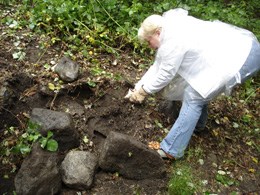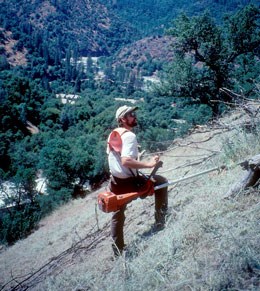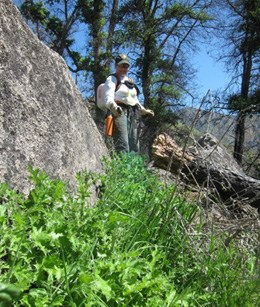
Treatment methods are tailored to their effectiveness in the context of worker safety and site-specific resources and conditions. First, non-native invasive plants are prioritized for treatment based upon their ability to alter the structure and function of native plant communities. For the highest-priority species, plant and site-specific management objectives are then developed, involving a combination of manual, mechanical and chemical control methods. Yosemite has used biological methods in the past, but none have been employed in recent years. All treatment methods have strengths and weaknesses, and in a large and complex park like Yosemite, an array of tools and techniques are needed to control invasives. Some treatments are appropriate in some situations while not in others. Special measures must be followed in protection zones such as designated wilderness, special-status species habitat, wetlands, riparian zones, archeological sites and traditional use areas. Invasive plant control in the park focuses on the handful of high-priority species that pose the greatest threat to the park resources. At present, 90% of our control resources are targeting the following five species, in order of importance: yellow star-thistle, Himalayan and cut-leaved blackberry, bull thistle, and velvet grass. Six other high-priority species occur in the park but control efforts are minimal because the species have been eradicated or nearly so: Italian thistle, perennial pepperweed, rush skeletonweed, Medusahead and spotted and diffuse knapweed. Cheat grass is another highly problematic plant, but it is already so widespread in Yosemite, that it cannot be effectively controlled parkwide. Local control projects do occur in areas of special concern, and in wilderness areas where cheat grass is not yet widely established. Control and TreatmentPrior to 2009, weed control in Yosemite was performed using only manual or mechanical methods. For fifteen years park managers tried to control aggressive invasive species such as Himalayan blackberry and yellow star-thistle with hundreds of volunteers. While many local successes were made, the overall spread of star-thistle and blackberry far outpaced the rate of control. The inefficient use of resources and the need for repeat treatments on these species has led managers to implement the use of herbicides as one of many tools to achieve effective control. 
Manual ControlManual control techniques use only non-mechanized hand tools. They are typically labor intensive, expensive and best suited to treat small patches or very sparse infestations spread across a large area. Examples include hand-pulling, lopping, and cutting the plants below the root crown using shovels. These methods can be appropriate treatment for perennials such as shrubs and trees that will not stump sprout after cutting or in areas where certain tools may not be appropriate, such as herbicide use near rare plants. Before plants disperse seeds, flowering heads and any existing fruiting bodies are bagged and disposed of. One successful use of manual control has been the treatment of spotted and diffuse knapweed. These plants have been consistently hand-pulled and have not spread into the wilderness. One great advantage of manual control methods is that they can be readily employed by volunteers. A major disadvantage of some manual control methods is the extensive ground disturbance and trampling of associated natives. These disturbed areas provide freshly exposed soil, the ideal habitat conditions for invasive plants to rapidly re-establish. Subsequent follow-up treatments can perpetuate the disturbance-invasive plant cycle. Furthermore, many areas in Yosemite have archeological resources below ground that can be disturbed by more disruptive manual methods. 
Mechanical ControlIn situations where invasive plants have completely overwhelmed a site, mechanical methods may be appropriate. Hand-held motorized equipment, such as brush cutters, quickly remove the above-ground portions of invasive plants. For example, using brush-cutters on flat terrain when 5% of the infestation is in bloom has proven effective in controlling yellow star-thistle in Yosemite. However, mechanical methods are often labor intensive, noisy, require more training and may involve significant collateral damage to non-target vegetation. Additionally, workers have sustained injuries when using brush-cutters in steep and rough terrain. Many mechanical control methods can only be employed during early season because of fire risk later in the summer. Mechanical mowing is also not a method suitable for use within designated Wilderness. 
HerbicidesLike all other methods of Integrated Pest Management, herbicide application has its own unique shortcomings that must be carefully weighed against its benefits of protecting park resources. For instance, more substantial training, documentation, and equipment are needed, and the application of herbicides frequently requires a large amount of clean water which may not be readily available in remote sites. Furthermore, the use of herbicide is more controversial than other IPM methods. Judicious use of herbicide can significantly increase the efficiency and effectiveness of invasive plant control, and the likelihood of decisively controlling infestations. This is significant because manual and mechanical treatments alone have not been able to contain some of our most aggressive invasive plants. One example came after many years of repeated unsuccessful manual treatments of tree of heaven in El Portal. A cut-stump herbicide treatment with a minor follow-up treatment the subsequent year controlled the problem. Targeted herbicide applications like this can kill invasive plants without any, or with very limited impacts to surrounding native plants. Another example is non-native blackberry treatment in Yosemite Valley. Managers treated a single 8.65 acre patch of Himalayan blackberry in 2009. The following year, only 0.34 acres of blackberry remained at the site;a reduction of 96% in a single year. No other method can realize this level of proficiency and cost-effectiveness. When using herbicides, the park conforms to standards above and beyond those required by the law to ensure the highest protection for applicators, visitors, wildlife, aquatic biota, water quality, and native plant species. The following methods are commonly used to apply herbicides in Yosemite National Park:Foliar Spray: Leaves are sprayed with a mixture of herbicide, water, non-ionic surfactant and an indicator dye from a backpack or other sprayer. Precise mixes are formulated according to label requirements, equipment calibration rates, species type, life cycle, and other factors. The dye is used to identify what has been sprayed which reduces overspray and repeat treatments. The park uses three delivery systems:
Cut Stump and Frill: Herbicides are applied to the freshly-cut stump of a woody species (tree, shrub, or vine). With the frill method, multiple cuts are made into the cambium layer, followed by immediate herbicide application with a brush or sponge. This method has the advantage of being very selective with high efficacy for some species. However, it is labor Wiper: Herbicides are applied to the leaves of plants with a wick, sponge, paintbrush, or similar tool. This method is also highly selective and labor intensive, but not as effective as foliar spray. Additional TechniquesOther techniques include changing land management practices to promote native species diversity. For example, prescribed fire can be used to maintain the overall natural diversity and functioning of an ecosystem, and potentially to exploit vulnerabilities in the life cycles of invasive plants. Two or more methods can also be combined to produce more synergistic results such as burning before herbicide treatment to remove excess biomass or thatch. Controlled BurningMost plant communities in Yosemite National Park evolved in the presence of periodic fire. Some species, such as the giant sequoia, will not germinate without fire. After being suppressed for decades, fire is now recognized as an important tool for maintaining the health of these communities. In some cases, fire is useful as a tool for managing invasive species. Fire is part of the ecological drivers in many ecosystems in the park, and it can be used to treat large areas effectively. However, it is non-selective and logistically difficult to implement. Furthermore, implementing fire is hazardous and risky, and has the potential to compound invasive plant problems. Firefighting equipment can be contaminated with invasive plant seeds, which is of particular concern when off-park crews and equipment are employed. During the post fire period of disturbance, the establishment and spread of invasive annual grasses such as cheat grass is promoted. Such species have the capability to completely displace native plant communities. Learn more about fire ecology. RestorationInvasive plants are less likely to become established where diverse native plant communities are already established, and restoring the healthy function of an ecosystem can increase its resilience to invasion. Restoration activities may incorporate reseeding as appropriate to aid in recovery and prevent invasive plant re-infestation. Active restoration is particularly useful in heavily disturbed areas, such as roadsides that lack a native seed bank. Biological ControlBiocontrol is a control method in which a plant's natural predators are released in order to manage an infestation. Since many of these plants have migrated from their point of origin without their predators, the introduction of an herbivore (such as a beetle that consumes seeds) or pathogen (such as a fungus) can infest and damage an invasive species. This is an effective method to treat large and widespread infestations as it continues to work for many years and requires little maintenance. Biocontrol agents must be selected with extreme caution and require long-term, rigorous trials before they can be released. They must be a highly specified predator that attacks only the target invasive plant. Yosemite National Park introduced a chrysomelid beetle (Chrysolina quadridemina) in Yosemite Valley to control Klamath weed (Hypericum perforatum) in the 1980s. In 1994 and 1995, the peacock fly (Chaetorellia australis), the hairy weevil (Eustonopus villosus), and the false peacock fly (Chaetorellia succinea) were introduced in El Portal to help control yellow star-thistle. Currently, no invasive species in the park require the further release of biological control agents to meet management objectives. Annual Work PlanView the Annual Invasive Plant Management Plan [2 MB PDF] and associated maps. The work plan summarizes the previous field season and proposed next year's treatments. The work plan describes the program's general approach as well as area specific plans. |
Last updated: August 5, 2024
